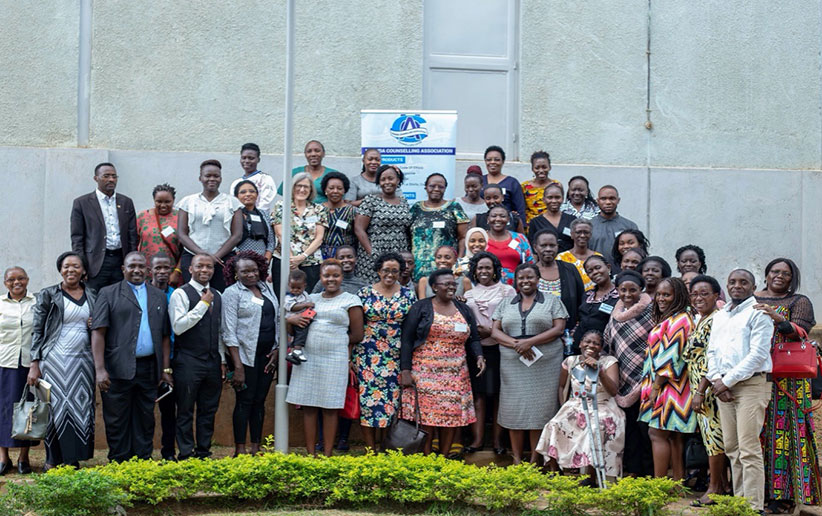Social justice is an evolving topic in marriage and family therapy (MFT) as the profession seeks to create this outcome in their clients’ lives and the systems in which they work. Many feel that creating systemic change is our work’s goal and responsibility. In the therapy room and as a leader, we are responsible for using the systemic knowledge we sought to make an impact and create change (AAMFT, 2015). This change can look different depending on the system within which a leader is working. Still, the overall goal is typically to make the interaction of all patterns healthier and more beneficial to all members involved. Working through a social justice lens is an excellent way to work toward systemic change that ensures equity and support for all system members.
Working through a social justice lens allows historically disadvantaged and marginalized individuals’ experiences to be centered for the first time within a system. The Clinical Guidelines for LGBTQIA Affirming Marriage and Family Therapy outlines how marriage and family therapists (MFTs) can practice affirming, inclusive, ethical, and competent therapy with lesbian, gay, bisexual, transgender, queer, intersex, and asexual (LGBTQIA) people. Guidelines provide instructions for what MFTs do or do not do in their clinical practice when working with LGBTQIA clients. These Guidelines should be considered a starting point for MFTs (for instance, a glossary of relevant terms can be found in Appendix A), not a comprehensive guide (AAMFT, 2022).
This article will use these Guidelines to outline the foundational principles necessary to create these changes through a social justice lens and incorporate them into leadership roles. The primary author’s lens is heavily influenced by his position as a COAMFTE program director. The secondary author’s lens is guided by her experience as a student in a COAMFTE-accredited program.
LGBTQIA Affirming Marriage and Family Therapy Guidelines
The Guidelines allow MFTs to hold themselves accountable for offering the best care to clients of various backgrounds, and it also presents a call to action. Utilizing systemic beliefs and practices is imperative when practicing affirmative care. This necessary component, the relevant ideas in our field, creates a necessity among MFTs to uphold these principles with all clients and use them to account for all diverse identities. Given the current socio-political climate within America and worldwide, there is a very present need for affirmative care in the mental health field and beyond. These Guidelines allow clinicians to practice therapy sensitive to varying identities and competent at creating equity in therapeutic relationships.
The Guidelines outline five main pillars: intersectional, systemic, relational, liberatory, and transformational (AAMFT, 2022). Each of these pillars will be defined throughout the article through the lens of the authors. To best understand the responsibilities of MFTs when it comes to affirmative care and how our ways of thinking can be implemented in treating clients of all backgrounds, please refer to the full Guidelines, as they provide the most comprehensive outline. Access a free copy of these in their full length here.
Five pillars and how to implement
 Intersectional
Intersectional
Pillar one is defined as intersectional. It describes the identities of an individual and how they may overlap, and is heavily guided by Crenshaw (1989). These aspects of identity overlap and the systems of marginalization and power intersect, creating privilege and oppression for different groups. Being intersectional invites therapists to decenter norms to create affirmative care (AAMFT, 2023). Specifically, marriage and family therapists (MFTs) practicing affirmative care for LGBTQIA populations must decenter cisnormativity and heteronormativity. Not only is it essential to decenter harmful normative systems, but it is equally vital to center the client’s experiences to provide care that meets them where they are and caters to their overlapping identities. Knowing a client’s social location is essential to center a client’s experiences when being intersectional properly (AAMFT, 2022). It is important to remember the various social structures outside of an individual’s identity and their impact on said identity. Therapists must acknowledge their clients’ social location and reflect independently (AAMFT, 2022).
Implementation
- A clear and direct handbook.
- Within the university setting, a handbook is one of the most direct ways of setting expectations for faculty and students. An in-depth handbook can offer students an idea of what they will put in and get out of their time within an MFT program. Setting clear expectations is important because it allows students, or members within an organization, to hold superiors accountable for equitable treatment and the absence of discrimination. When doing this, having members sign an agreement to the handbook is helpful to gain consent and ensure everyone is on the same page.
- Clear roles and responsibilities of all parties involved.
- Along with clear expectations for how a program or organization is run, it is also helpful to establish specific roles and responsibilities for all members. This is beneficial in becoming intersectional as it eliminates unspoken rules and creates tangible benchmarks that all members can agree on. The most important way to implement intersectionality is to create transparency in the conversations and culture within a system. In their policies, leaders hoping to be intersectional must create transparency to improve integrity and accountability within the system, even at the highest level. Each avenue towards intersectionality inspires equity in how a system is run and feedback is handled.
 Systemic
Systemic
The second pillar, systemic, is quite familiar to MFTs. Systemic thinking is a foundational piece of our field and fits in well regarding affirmative care for LGBTQIA clients. This pillar considers the various external systems and organizations that impact individuals. Instead of seeing individuals and their identities as the root of a problem, a systemic view looks into circular patterns and relationships affecting individuals to create a more comprehensive understanding of the issue (AAMFT, 2022). This pillar promotes nonpathology as it considers the individuals’ knowledge of what is or is not healthy for them (AAMFT, 2022). MFTs following these Guidelines recognize the harm caused by the Diagnostic and Statistical Manual of Mental Disorders (DSM) in previous editions wherein the LGBTQIA community was pathologized (AAMFT, 2022). With this acknowledgment, there is also a responsibility to diagnose Gender Dysphoria with great care and should be limited only to when it is necessary for access to care (AAMFT,2022).
Implementation
- Create a hierarchy chart.
- A hierarchy chart can guide a culture built on a clear understanding of systemic factors to give a reliable chain of command. Hierarchy charts enable members of the system to provide feedback in a more streamlined fashion. In response to this feedback, having a culture of flexibility is the best way to create equity and maintain a system that works against stagnant power structures and unnecessary stressors. Again, transparency is a huge part of using a social justice lens in leadership; outlining responsibilities is excellent.
- Model self-care as a leader.
- As a therapist, we constantly discuss the need for self-care, but we rarely model how to do so. Self-care is just as important as a leader and can be done by openly discussing boundaries around email, scheduling meetings, scheduling classes, etc. A specific way this can be modeled is via an email signature that offers no expectation for quick responses or a response outside the recipient’s work hours.
- Here is an example: If you received this email outside your typical working hours, I hope you feel free not to read or respond until your schedule and workload permit. I generally do not respond to emails on the weekend, and I typically reply in 24-48 hours, Monday – Friday.
- As a therapist, we constantly discuss the need for self-care, but we rarely model how to do so. Self-care is just as important as a leader and can be done by openly discussing boundaries around email, scheduling meetings, scheduling classes, etc. A specific way this can be modeled is via an email signature that offers no expectation for quick responses or a response outside the recipient’s work hours.
 Relational
Relational
The third pillar, relational, is fundamental given the protective factor relationships can have for the LGBTQIA community (AAMFT, 2022). Starting from a larger lens, awareness of national and global relationships allows MFTs to understand the diverse contexts within which LGBTQIA clients exist (AAMFT, 2022). This awareness also places a responsibility on clinicians to pursue advocacy and create professional relationships to establish a network of resources for these clients (AAMFT, 2022). Narrowing the scope, community relationships also have a significant impact on individuals. These relationships can reflect a client’s intersecting identities as there are multiple layers of support, or lack thereof, depending on which identifying factor is examined (AAMFT, 2022).
Implementation
- Gatherings vs Meetings (Parker, 2018).
- Emphasizing this relational pillar in leadership can also enhance and strengthen the culture created within a system. One way to do this is to have gatherings in addition to, or rather than, meetings. Gatherings are designated times to build community and relationships and have a more casual feel. On this same note, the meetings within a system should aim to be purposeful. Purposeful meetings reduce the potential for resistance to build up at the idea of seeing others within a system and allow individuals to have more robust and more positive relationships. Creating the space and setting expectations is helpful to all involved regarding either form of group interaction. These steps allow for continued transparency and build an affirming culture in a system.
- Bring unspoken relationship rules to the spoken.
- Systems build and create unspoken rules. It is essential to bring these unspoken expectations to the surface through a social justice lens. Create a dialogue about the expectations and build a policy that reflects these expectations.
- Checks and Balances.
- When there is a culture of openness and feedback, members of an organization can assist in monitoring the system for biases and assumptions that may have gone unnoticed. Checkpoints can be instrumental in maintaining this culture and promoting honest feedback. Consistently reviewing practices is also helpful as it allows for a check of biases even within the structure itself. As a leader, implementing this pillar becomes more personal with the need to examine internalized superiority that can result from some aspects of social location (for example, white male privilege) and hierarchical privileges. Diversity is another important factor because it can be challenging to determine the most equitable course of action without all voices being represented.
 Liberatory
Liberatory
The fourth pillar is liberatory and describes the need for MFTs to free themselves from the systems causing harm to their clients to provide more sensitive and affirming care (AAMFT, 2022). This does not just mean advocacy but also includes an internal reflection. To incorporate this pillar into social justice leadership, a leader has to be willing to examine their own biases, assumptions, and beliefs (AAMFT, 2022). Affirming leadership cannot be facilitated when preferences are present due to the nature of what it means to be biased. Internalized superiority can also be problematic in a system, and MFTs should seek to dismantle this within themselves to create equality (AAMFT, 2022). Creating a more leveled interaction is helpful in leadership, and it allows the therapist and client to engage in a more collaborative relationship recommended by the Guidelines (AAMFT, 2022).
For this pillar, Dismantling Racism Works (dRworks) is an essential resource. This website provides free resources for leaders to shift their mindset, move away from white supremacy, and shift their organization’s culture. The authors recommend reviewing the entire website and here are some examples of ways to understand and move away from the impact of white supremacy (Okun, 2021).
Implementation
- Work to undo the impact of White Supremacy (Okun, 2021).
- Move away from perfectionism and develop a culture of appreciation.
- Move away from a sense of urgency and develop a culture of realistic work plans and timelines.
- Try to normalize a 10-workday process for a turnaround when requesting feedback and edits on policy, procedure, and system changes.
- Share power in the system. Do not hoard it.
 Transformative
Transformative
The fifth and final pillar is labeled as transformative and follows the theme created throughout the other pillars by emphasizing the need for advocacy. As systemic providers, MFTs are responsible for acknowledging systems’ impact on individuals and the need for change within those systems (AAMFT, 2022). Accountability, reflexivity, and reflectivity are crucial in not recreating harmful system effects within the therapy room (AAMFT, 2022). These practices are helpful beyond the therapy room as they are also crucial to advocating for clients’ rights. Advocacy like this extends not only into the rights of the LGBTQIA community but also into the promotion of representation in places where decisions are being made regarding those rights (AAMFT, 2022). An MFT leading with a social justice lens ideally keeps up with the local and federal laws so that clients can be met with care and can focus on their emotional responses instead of the responsibility of advocating within therapy.
Implementation
- Advocacy
- The field of MFT is ever-changing and constantly evolving as new research is done and more voices are heard. With all these changes, having accurate representation and advocacy is more important than ever. Inclusivity should be promoted, expected, and celebrated. It is an injustice to clients if anything less is tolerated. Leaders must set a transformative tone and promote advocacy within their organizations, and this extends to the workplace and involves politics and advocating for affirmative care while fighting against anti-queer and trans laws and other harmful practices.
- Collaboration
- Leaders should work to collaborate with all that is included in the system. When changes to the system are being discussed, the voices of those impacted by the change must be present. For example, if a program director wants to implement changes to the program, including the feedback of faculty and students is essential.
Social justice looks different at every level and within each organization. Even at the most minor level, it can have a significant impact. While the work can often seem overwhelming, change must start somewhere. As MFTs, we have a great awareness and ability to understand the Guidelines outlined above and a duty to act on them to create safety and healing for those unable to dismantle barriers. Getting involved can start within AAMFT thanks to networks like the Queer and Trans Advocacy Network (QTAN), Family Team, and Margins to Center: Cultural Connections Among C/MFTs.

M. Evan Thomas, PhD, LMFT, is an AAMFT Professional member holding the Approved Supervisor designation. Dr. Thomas is an assistant professor, department chair, and program director of the COAMFTE-accredited MMFT Program at Converse University in South Carolina. Additionally, he is the current AAMFT QTAN chair and owner of Thomas Counseling Services, LLC, in Greenville, SC. His private practice focuses on the queer community and substance misuse. Evan.thomas@converse.edu

Lauren Pittman, MMFT, is an AAMFT Student member and Marriage and Family Therapy graduate student who recently graduated from Converse University’s Master of Marriage and Family Therapy program. She will pursue her PhD in Human Development and Family Science with a concentration in Marriage and Family Therapy at Virginia Tech starting August 2023. She is a member of the Queer and Trans Advocacy Network (QTAN). She hopes to focus her research on the experiences of the queer community, highlighting those of bisexual women. lpittman@vt.edu
American Association of Marriage and Family Therapy (AAMFT). (2015). AAMFT Code of Ethics. Retrieved from https://www.aamft.org/Legal_Ethics/Code_of_Ethics.aspx
American Association of Marriage and Family Therapy (AAMFT). (2022). Clinical Guidelines for LGBTQIA Affirming Marriage and Family Therapy. Retrieved from https://www.aamft.org/store/detail.aspx?id=DLCGLAMFT
Crenshaw, K. (1989). Demarginalizing the intersection of race and sex: A Black feminist critique of antidiscrimination doctrine, feminist theory, and antiracist politics. University of Chicago Legal Forum, 8(1),139-167. https://chicagounbound.uchicago.edu/uclf/vol1989/iss1/8/
Okun, T. (2021). White supremacy culture: Still here. Retrieved from https://drive.google.com/file/d/1XR_7M_9qa64zZ00_JyFVTAjmjVU-uSz8/view
Parker, P. (2018). The art of gathering: how we meet and why it matters. New York, Riverhead Books.
Other articles
On the Horizons: Barriers and Trends in the Development of Systemic Family Therapy in Africa
Systemic family therapists (SFTs), usually called marriage and family therapists (MFTs) in North America, are trained to conceptualize individual, couple, and family distress within the broader relational and diverse intersectional contexts in which people live.
Ronald Asiimwe, MS & Elmien Lesch, PhD
Culturally Informed Marriage and Family Therapy with the Chinese Population
In light of the growing recognition of the importance for marriage and family therapists (MFTs) to be sensitive to their clients’ cultural backgrounds and memberships, this article is intended to provide several culturally-informed clinical suggestions for therapists applying Western-based MFT theories, models, and concepts to the Chinese population.
Yinan Li & Huan Liu
Neurocriminology: A Call on Marriage and Family Therapists and Allied Disciplines to Become Informed
Neurocriminology is an interdisciplinary subfield of criminology that incorporates methodological approaches from neuroscience, physiology, genetics, biology, and psychology. The goal of neurocriminology is to better understand, predict, prevent, and treat criminal and violent behaviors.
Jerrod Brown, PhD



